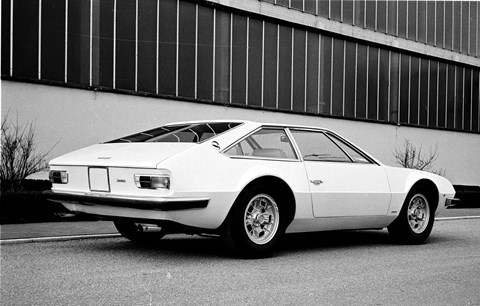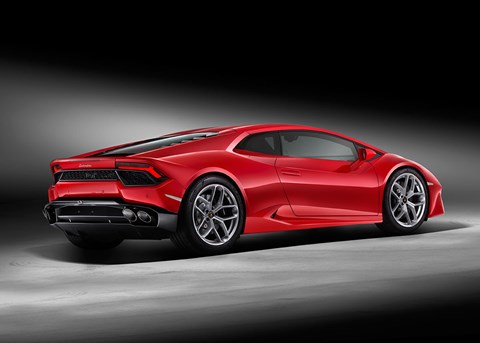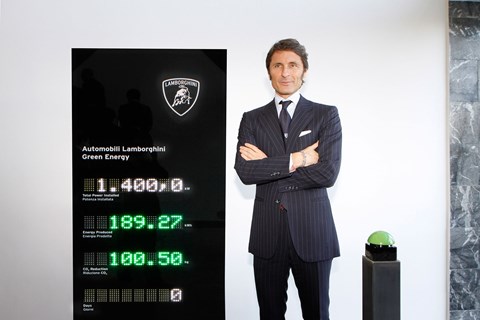► Lambo product planning scoop dossier
► What will its fourth product range be?
► New Espada or Jarama front-runners
We have yet to hear from the new president Stefano Domenicali his vision for the future of Lamborghini, but to his predecessor Stefan Winkelmann electromobility was an integral part of every future sports car concept.
Take the new SUV badged Urus for instance. From 2019 onwards, the outrageously fast Lambo 4×4 will be offered with a plug-in hybrid drivetrain inspired by what Audi has prepared for the Q7. It’s the only way for Lamborghini to survive: preparing OTT for the low CO2 age.
This new eco responsibility is sometimes at odds with Lambo’s mission statement. Not yet part of the brand’s ‘greenification’ is the Aventador supercar, which will retain its iconic V12 through the end of the current lifecycle in 2022.
A fourth Lamborghini model range
To be discussed in the near future are the next-generation Huracan and a fourth model range, which could either be a contemporary Jarama/Espada (below) reincarnation or a recreation of the legendary Miura. In both cases, provision will have to made for inductive charging, according to CAR magazine’s engineering moles.

Since Lamborghini is operating under the Audi umbrella, every strategic rethink must be signed off by Ingolstadt. But there are other factors and possible partners to be considered, too. Porsche’s MSB architecture (Panamera II) would have to be shared should the Italians want to create a 2+2-seater, Bentley could bring its 2020 Speed 6 coupé and roadster to the table, and the German parent company may address Lamborghini when compiling the replacement for the poorly packaged and expensive-to-build R8.
Demand for the R8 is currently so slow that financial controlling is contemplating moving production from Neckarsulm to the Huracan line in Sant’Agata, we hear. Although the Huracan is meeting sales expectations, product planning wants to steer the follow-up model further away from the Aventador both in looks and specification.
Political war games in the VW Group
As far as the big picture goes, the most critical stumbling block on the way to a fresh contemporary Lamborghini line-up is the Not Invented Here syndrome.
Under the previous leadership, the Italians intended to use a new modular carbonfibre architecture for the Huracan and Aventador replacements. Porsche and Bentley played no role at all in this scenario, but Audi was pitching to adapt an aluminium-intensive version of this central backbone matrix for the next R8.
The group’s MSB architecture on paper has everything it takes to trigger a successor to the Porsche 928, the aforementioned Bentley Speed 6, a possible heir to the Jarama and Espada grand tourers, and the on/off four-seater Audi Quattro Sport. You guessed it: apart from more Not Invented Here objections being encountered by Domenicali.

The disparate parties involved are struggling to reach a synergy-generating consent in terms of electrification. Porsche is pushing through its bespoke J1/Mission E four-door coupé, Bentley is eyeing a smog-free crossover, Audi has derived its Q E-tron from the conventional Q7 parts kit, while VW – still smarting from the Dieselgate disaster – is developing from scratch a whole family of electric MEB cars.
While the Lamborghini Urus rides the same genetic wave as the Cayenne crossover crowd, the sports cars are on a different orbit. Aventador and Huracan will almost certainly form a team again, and while it is relatively easy to pull them further apart in terms of size and price, it is not yet clear at all which engines to use in an increasingly regulated environment.
Lamborghini’s engine strategy
Problem child number one is the charismatic naturally aspirated V10 which no longer stands a chance against the 488 and the hot 911s of this world without serious tinkering.
While deposed VW group scion Ferdinand Piech’s idea to integrate Ducati’s emotional and powerful high-revving razor-sharp desmodromic valvegear is facing serious maintenance and emission issues, adding a pair of turbochargers to the V10 would almost automatically kill the free-breathing V12 in the Aventador (below).

A clever way out of this dilemma could arrive in the shape of a 150kW electric motor driving the front wheels, a 50kW e-power pack integrated in the transmission and thus propelling the rear wheels, and a wide centre tunnel filled with batteries rather than a propshaft.
If need be, this scalable layout could even go fully electric. That way, Lambo would be able to keep its adrenaline-producing V10 and V12 a little longer, while at the same time doing a good turn to the environment.
What about that third sports car?
So far, the nuova Miura project is little more than a paper tiger. If its goal is to the beat the likes of LaFerrari, P1 and 918, it would also challenge the Aventador in an in-house clash of two partially electrified titans.
Below the Aventador, however, there is plenty of room to move for a 21st century Miura – as long as the string-pullers are willing to reposition the Huracan. Which is entirely possible, except that such a move would leave Lamborghini with three mid-engined sports cars powered by a set of electrically-assisted V8, V10 and V12 engines.

In addition to likely objections from sales and marketing, no CFO would sign off the hideously expensive common carbonfibre architecture. So maybe that third sports car should be front-engined after all.
As far as the hardware goes, it’s all there for the taking; the catchword is MSB. In either case, the engine of choice would likely be a 550bhp-plus tri-turbo 3.0-litre V6 which makes the heavier and thirstier V8 all but obsolete.
Radical change for the masters of outrage
For small car makers like Lamborghini, moving away from combustion engines is a high-risk endeavour even when undertaken step by step. When is the time right to introduce the first e-power model? How to best stagger the launch sequence? Which means to select for inter- and intra-brand differentiation? Are the customers early or slow adopters?
Tapping MSB would of course greatly reduce the financial risk, but so would redefining Lamborghini’s own pending modular sports car platform. If this matrix was as flexible in material composition as it must be dimensionally, one could perhaps after all derive a carbon-intensive Aventador replacement and a steel-intensive baby Huracan from the same DNA.
From his new vantage point at the top of Audi’s Quattro division, Stefan Winkelmann (below) must be watching this Verdi-esque opera buffa with interest and, perhaps, a touch of melancholy.
